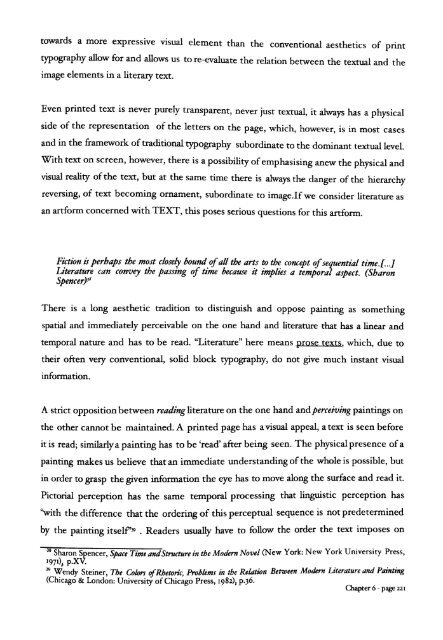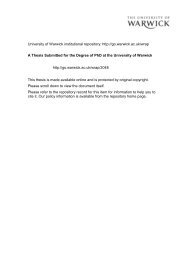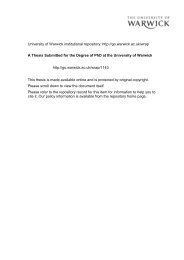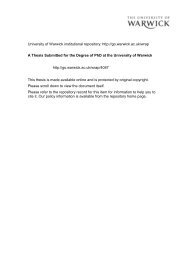From Page to Screen - WRAP: Warwick Research Archive Portal ...
From Page to Screen - WRAP: Warwick Research Archive Portal ...
From Page to Screen - WRAP: Warwick Research Archive Portal ...
Create successful ePaper yourself
Turn your PDF publications into a flip-book with our unique Google optimized e-Paper software.
<strong>to</strong>wards a more expressive visual element than the conventional aesthetics of print<br />
typography allow for and allows us <strong>to</strong> re-evaluate the relation between the textual and the<br />
image elements in a literary text.<br />
Even printed text is never purely transparent, never just textual, it always has a physical<br />
side of the representation of the letters on the page, which, however, is in most cases<br />
and in the framework oftraditional typography subordinate <strong>to</strong> the dominant textual level.<br />
With text on screen, however, there is a possibility ofemphasising anew the physical and<br />
visual reality ofthe text, but at the same time there is always the danger of the hierarchy<br />
reversing, of text becoming ornament, subordinate <strong>to</strong> image.If we consider literature as<br />
an artform concerned with TEXT, this poses serious questions for this artform.<br />
Fiction isperhaps the most closely bound ofall the arts <strong>to</strong> the concept ofsequential time.[...}<br />
Literature can convey the passing of time because it implies a temporal aspect. (Sharon<br />
Spencerl"<br />
There is a long aesthetic tradition <strong>to</strong> distinguish and oppose painting as something<br />
spatial and immediately perceivable on the one hand and literature that has a linear and<br />
temporal nature and has <strong>to</strong> be read. ''Literature'' here means prose texts, which, due <strong>to</strong><br />
their often very conventional, solid block typography, do not give much instant visual<br />
information.<br />
A strict opposition between reading literature on the one hand andperceiving paintings on<br />
the other cannot be maintained. A printed page has a visual appeal, a text is seen before<br />
it is read; similarlya painting has <strong>to</strong> be 'read' after being seen. The physical presence ofa<br />
painting makes us believe that an immediate understanding ofthe whole is possible, but<br />
in order <strong>to</strong> grasp the given information the eye has <strong>to</strong> move along the surface and read it.<br />
Pic<strong>to</strong>rial perception has the same temporal processing that linguistic perception has<br />
''with the difference that the ordering of this perceptual sequence is not predetermined<br />
by the painting itself'> . Readers usually have <strong>to</strong> follow the order the text imposes on<br />
38 Sharon Spencer, Space TimeandStructure in the Modern Novel (New York: New York University Press,<br />
1971)1 p.XV: . . .<br />
39 Wendy Steiner, The Colors ofRhe<strong>to</strong>ric, Problems in the Relation Between Modern Literature and Painung<br />
(Chicago & London: University ofChicago Press, 1982), P.36.<br />
Chapter 6 - page 221





